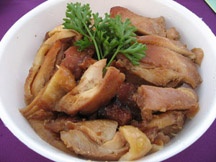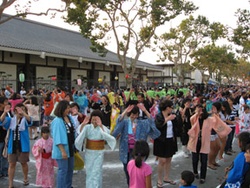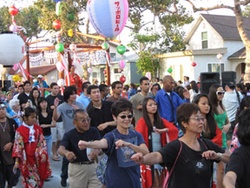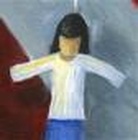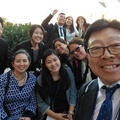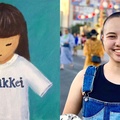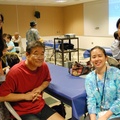I feel very fortunate to live in an area that has so many Obon festivals that are relatively accessible if you’re willing to drive. There are three in the Little Tokyo area alone. In addition, I’ve attended or have heard of others at Gardena Buddhist Church, San Fernando Valley Hongwanji Buddhist Temple, Senshin Buddhist Temple, Pasadena Buddhist Church, Oxnard Buddhist Temple, Venice Hongwanji Buddhist Temple, West Covina Buddhist Temple, West Los Angeles Buddhist Temple, and Orange County Buddhist Church. I even know people who drive as far as San Diego and Las Vegas to attend Obon annually.
What’s so great is that they spread out their schedules so that it’s possible to attend more than one. The ones I mention above run from the last weekend in June to mid-August. As a result, there are a lot of people who try to attend as many as they can during Obon season. I’ve heard them referred to as “Obon Junkies.” I’m not diehard enough to qualify, but I do try to go to at least the ones that are closer to me whenever my schedule is open.
Growing up, I rarely attended Obon festivals. I remember going to the Gardena Obon on occasion, but it was because two of my uncles belong to the church. We would say “Hi” to my Uncle Roy who would always be working in the chicken teriyaki booth, eat some food, maybe play some bingo, and then head home.
That changed when I started working at the Japanese American National Museum. At that time, I worked both Saturdays and Sundays. When July came, I saw volunteers and staff coming back from the various Little Tokyo area festivals with food, baked goodies, plants, and vegetables. Out of curiosity, I began going at lunchtime. There were four within walking distance then—Nishi Hongwanji Buddhist Temple, Zenshuji Soto Mission, Higashi Honganji Buddhist Temple, and Koyasan Buddhist Temple. Now, I’m hooked. I look forward to going each year. I check the schedule to see which ones I can go to and write them down in my calendar with anticipation.
To be honest, I go mostly for the food. I like to sample and compare to see what each has to offer. Each seems to have their own specialties and ways of doing things. Even something as standard as teriyaki can be cooked and prepared in so many different ways. By comparing the offerings, you can also find regional influences—many Southern California Obon have tamales with chili alongside spam musubi and udon.
Besides the food, the other thing that I love about going to Obon festivals is the feeling that I’m a part of the community. Between my family, friends and acquaintances, people I know from the Museum, and the organizations I’m involved with, I see a lot of familiar faces. It’s an opportunity to connect not only with my Nikkei culture, but people in the community.
One thing I really noticed this year was the visible support from other churches that are reflected by the happi coats worn by Obon-goers of different temples and organizations. This summer, I attended Orange County and Gardena’s Obon. At each, I saw a wonderful variety of colorful happi coats representing temples from as far as Oxnard and Sun Valley, as well as many of the churches in between. There were also matching happi coats and other outfits from organizations like the Terminal Islanders and Gardena’s Japanese Cultural Institute. Then there were others who dressed up in yukata, happi, or other Japanese-style clothing or accessories to get into the spirit. In Gardena, there are a lot of Japanese Americans originally from Hawai'i, so I even saw a few happi from Hawaiian Buddhist churches, as well as Hawaiian-influenced clothing designs and people wearing lei.
Seeing all of these people proudly wearing their happi, yukata, and other clothing as they lined up for the ondo dancing was really amazing to watch. They dance around the yagura, which is a raised platform where the announcer and often a taiko drummer stands on. At Gardena, they mark off multiple lanes for dancers in chalk on the street next to the church. The yagura is near the church’s gate in the middle of the street and the lanes go around it in a really long oval, extending all the way down the entire block. There a lot of people who just come to watch the dancers. Many people set up chairs along the ondo area from early in the morning. I talked to someone who said that they set up their chair at 10am and by then there were already chairs set up about 1/3 down the street (the Obon didn’t start until 2pm that day and the ondo didn’t start until 6pm).
As I took photos of the ondo dancers and ate my dango (deep-fried, donut hole-like goodies), I was fascinated by the diversity represented both by the food, as well as the people who attended. There’s a great mix of younger Sansei, Yonsei, and Gosei; older Nisei, Kibei, and Shin-Issei; as well as Hapa and non-Japanese, that creates a vibrant portrait of what the future of the community can be.
I mentioned earlier that in Little Tokyo, there are now three Obon festivals, but that I used to attend four of them. It’s because Koyasan no longer holds an Obon festival. Sadly, they stopped a number of years ago because the people organizing it were getting older and there weren’t enough younger people to take over. That seems to be the problem facing a lot of Nikkei institutions and traditions everywhere.
However, I am encouraged by how well some of the other Obon are doing. At some at least, there is a changing of the guard happening. At Gardena, my Uncle Roy has “retired” from the teriyaki BBQ chicken booth, and there are now younger volunteers who have taken over. This passing of the “torch” is critical to whether our community traditions live on for future generations.
It would be tragic if we were to lose these community events. I’m sad just to see another Obon season coming to a close...I can’t wait until next year!
*Photos from the Orange County Buddhist Church Obon and Gardena Buddhist Church Obon by Vicky Murakami-Tsuda.
© 2007 Vicky Murakami-Tsuda


